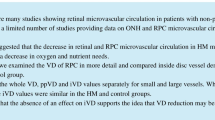Abstract
Background
Optical coherence tomography (OCT) was used to detect peripapillary neural tissue loss (PPNTL) over the disc crescent in pathologic myopia. The retinal neural tissue loss located inside the disc crescent in pathologic myopia is a newly recognized fundus lesion.
Methods
Review of ten eyes of ten patients with peripapillary yellowish-white retinal lesions who underwent OCT for evaluation of the nature of PPNTL in pathologic myopia. OCT, fluorescein angiography, automated visual fields, axial length measurement with ultrasound A scan, and ultrasound B scan were performed.
Results
Ten eyes of ten patients were identified during a 14-year period to have findings characteristic of PPNTL. The mean age of the patients was 46 years. They were followed up for an average of 9 years. The mean spherical equivalent correction was −10.50 diopters (D) (range −6.0–−16.0 D). The mean axial length was 28.6 mm (range 26.30–31.50 mm). In each case, OCT showed a complete retinal discontinuity in the PPNTL lesion. Automated visual field examination showed corresponding arcuate scotoma. During the follow-up period, the inner retina layer of the retinal defect margin was elevated by posterior hyaloid and partial retinal detachment developed in one eye.
Conclusions
PPNTL in pathologic myopia is a relatively asymptomatic, yellowish-white peripapillary retinal discontinuity. Recognition of this lesion is important because the visual field defect may mimic glaucomatous changes owing to the loss of nerve fiber layer. Progressive partial retinal detachment may ensue as one of the complications of the peripapillary lesion.




Similar content being viewed by others
References
Adam BT, Jay IP, Richanrd G (2001) A transparent peripapillary staphyloma in pathologic myopia. Retina 21(4):373–375
Balacco-Gabrieli C (1982) Aetiopathogenesis of degenerative myopia—a hypothesis. Ophthalmologica 185:199–204
Chakravarti S, Paul J, Roberts L, Chervoneva I, Oldberg A, Birk DE (2003) Ocular and scleral alteration in gene-targeted lumican-fibromodulin double-null mice. Invest Ophthalmol Vis Sci 44:2422–2432
Curtin BJ (ed) (1985) The myopias. Harper & Row, Philadelphia
Del Priore LV, Hornbeck R, Kaplan HJ, et al (1995) Debridement of the pig retinal pigment epithelium in vivo. Arch Ophthalmol 113:939–944
Del Priore LV, Hornbeck R, Kaplan HJ, Jones Z, Swinn M (1996) Retinal pigment epithelial debridement as a model for the pathogenesis and treatment of macular degeneration. Am J Ophthalmol 122:629–643
Freund KB, Ciardella AP, Yannuzzi LA, Pece A, Goldbaum M, Kokame GT, Orlock D (2003) Peripapillary detachment in pathologic myopia. Arch Ophthalmol 121(2):197–204
Greene PR (1980) Mechanical considerations in myopia: relative effects of accommodation, convergence, intraocular pressure, and the extraocular muscles. Am J Optom Physiol Opt 57:902–914
Grossniklaus HE, Green WR (1992) Pathologic findings in pathologic myopia. Retina 12;127–133
Hee MR, Puliafito CA, Wong C et al (1995) Optical coherent tomography of macular holes. Ophthalmology 102:748–756
Ho TC, Del Priore LV (1997) Reattachment of cultured human retinal pigment epithelium to extracellular matrix and human Bruch’s membrane. Invest Ophthalmol Vis Sci 38:1110–1118
Jaffe GJ, Caprioli J (2004) Optical coherence tomography to detect and manage retinal disease and glaucoma. Am J Ophthalmol 137:156–169
Lin LLK, Shin YF, Ho TC, Wang TH, Chen CJ, Hung PT (2001) The refractive status of middle-aged and elderly population in Chin-Shan Xiang, Taipei county. Trans Soc Ophthalmol Sinicae 40:1–8
Noble KG, Can RE (1982) Pathologic myopia. Ophthalmology 89:1099–1100
Puliafito CA (ed) (1996) Optical coherent tomography of ocular diseases. Slack, Thorofare, NJ
Steidl SM, Pruett RC, Richard G (1997) Macular complications associated with posterior staphylloma. Am J Ophthalmol 123:181–187
Author information
Authors and Affiliations
Corresponding author
Rights and permissions
About this article
Cite this article
Ho, TC., Shih, YF., Lin, SY. et al. Peculiar arcuate scotoma in pathologic myopia—optical coherence tomography to detect peripapillary neural tissue loss over the disc crescent. Graefe's Arch Clin Exp Ophthalmol 243, 689–694 (2005). https://doi.org/10.1007/s00417-004-1107-4
Received:
Revised:
Accepted:
Published:
Issue Date:
DOI: https://doi.org/10.1007/s00417-004-1107-4




